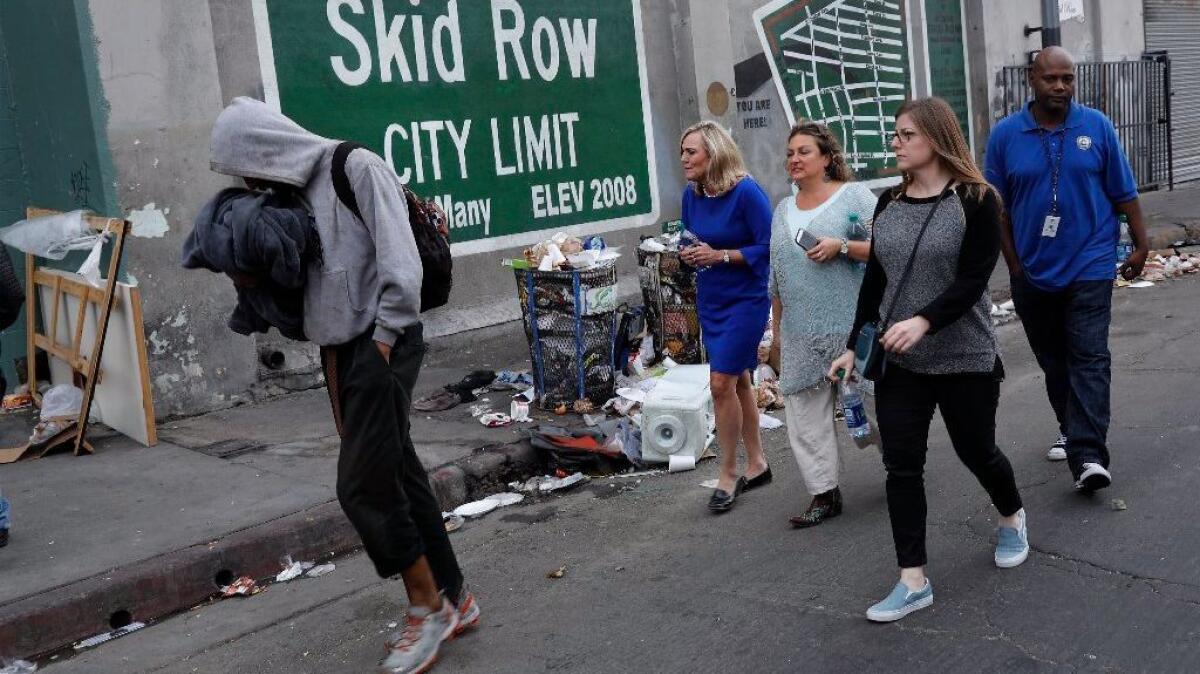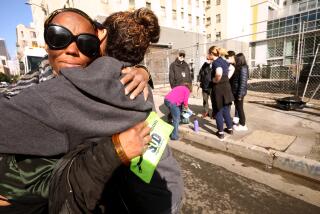Column: What if this homeless woman were your mother — would you keep moving or step in to help?

You’ve seen them. I’ve seen them.
Everyone has.
You’re walking or driving in downtown Los Angeles, Hollywood, Venice or one of the dozens of other places where homeless people gather, and you see someone who stands out.
Someone who’s not just homeless, but is clearly ill in more ways than one.
It’s a Third World sight, not the kind of thing you’d expect in a rich, civilized society.
But there it is, a fixed and disturbing part of the L.A. landscape. You’ve grown weary of seeing it and reading about it. Even if you’d like to help, you don’t know where to begin. So you keep moving.
But Dr. Susan Partovi can’t do that.
“I certainly wouldn’t want my mother to live like that,” the medical director of Homeless Healthcare Los Angeles said Monday afternoon as we walked through skid row.
Partovi, mental health outreach worker Anthony Ruffin and others have been lobbying all year for authorities to stop, ask how this can be and do something about it. Even when the person on the street says no thanks. And they’ve gotten the attention of L.A. County Supervisor Kathryn Barger, among others.
On Monday, Barger and the others walked past the tents, past the reefer smoke and the stench of rotten food, past shopping carts and the scabbed and dirty feet poking out from under blankets on skid row.
Hundreds of homeless people were out there on a gray day — the sick, the deranged, the evicted, the broke, the drinkers, the dealers, the dangerous, the sad and the hungry — with an entire village camped in the courtyard of one shelter where people line up early and wait in line for a slab of pavement.
A small percentage of L.A. County’s more than 50,000 homeless people are gravely ill, both mentally and physically. Trying to help the sickest, if they resist, is difficult.
But we’ve settled for the alternative.
Partovi described one of her worst cases:
“She’s got rheumatoid arthritis, her hands are like this, she’s covered in scabies and lice, she’s blind, she’s emaciated, and she’s probably the next one to die.”
But the law stands in the way of helping such people.
“I’ve been told that if you brought five different law enforcement agencies in and asked each one to give their interpretation of 5150, they would all be very different,” Barger said, referring to the civil code for the commitment of someone with a mental disorder. “And some of it is based on resources.”
Ruffin agreed that when the overwhelmed mental health system is running particularly short on doctors, beds and treatment programs, it’s harder to bring someone in. It took years for Ruffin to finally arrange the commitment of a desperately ill homeless woman who lived in the same exact spot for so long in Hollywood, the sidewalk was stained by her body waste.
There’s got to be more consistency, Barger argued, and one answer is better training of police and paramedics on what qualifies as grave disability. Another idea is to have psychiatrists on the street to assess mental conditions.
Under existing law, people with a mental disorder can be taken in for evaluation against their will if they’re deemed a danger to themselves or others or they’re gravely disabled. Partovi and others have recommended broadening the grave disability standard to include obvious signs of physical deterioration and medical disorders in those who lack the mental capacity to seek treatment.
“It’s not enough just to get people into hospitals,” said Barger, adding that seriously disabled people need consistent follow-up treatment and placement. It may be necessary, she said, to legally conserve those who choose to walk away from treatment, only to return to the same conditions that led to their physical and mental deterioration.
To be perfectly honest, none of that is cheap or easy. But as encampments have multiplied across the region, voters have approved billions of dollars’ worth of funding for housing and care. If public officials can’t make progress now, when will they ever?
At Sixth and Stafford streets, we came upon a barefoot, soft-spoken woman in her 60s. She sat on the curb near a makeshift tent, bits of scattered trash at her feet. She said she’d been homeless a short time, but Ruffin said it was closer to 20 or 30 years. Partovi said the woman had been offered housing but refused.
That’s not uncommon in the case of someone who’s suffering with a mental illness. An estimated one-third of homeless people have a mental illness and more than 4,000 people in county jails have such disorders. In mid-October, the Board of Supervisors approved a Department of Mental Health plan to provide better treatment at every level.
But there was no agreement on one item — a call by Barger and Supervisor Hilda Solis to expand the grave disability standard.
That changed at Tuesday’s meeting.
Supervisors heard from Partovi and Ruffin, and Barger spoke about her trip to skid row a day earlier.
By a 4-1 vote, supervisors called for staff to study the issue and report back in 45 days.
The lone dissenter was Sheila Kuehl, whose opinion I respect.
Kuehl is a longtime advocate for the mentally ill, and to be honest, I’ve been on both sides of this issue in the past. I’ve wrestled over the years with how to best advocate for a dear friend of mine with a serious mental illness but a fierce resistance to treatment.
But he was committed on a 5150, and he’s now safe, comfortable and in treatment.
I hope Kuehl keeps speaking up as the conversation moves forward. She has legitimate concerns about violating civil liberties with forced treatment and medication that isn’t always effective.
We have an ugly history, in this country, of over-institutionalization and criminalization of the mentally ill.
But we followed that up with not doing nearly enough.
At Tuesday’s meeting, Ruffin testified about a severely disabled man who lives in an alley, still wearing a hospital I.D. after being treated for a stroke and released.
“Why can’t we get these people...treated?” he asked. “It can be done in a humane way.”
Barger spoke of the barefoot skid row resident she met Monday.
“This is a woman...who is going to die on our streets,” Barger said. “While we cannot help everybody, there are those that we have a moral obligation to help.”
Get more of Steve Lopez’s work and follow him on Twitter @LATstevelopez
More to Read
Start your day right
Sign up for Essential California for news, features and recommendations from the L.A. Times and beyond in your inbox six days a week.
You may occasionally receive promotional content from the Los Angeles Times.







